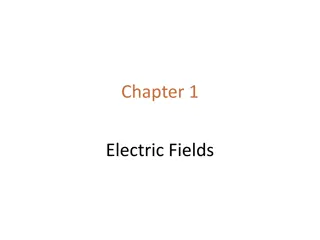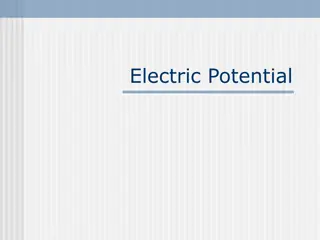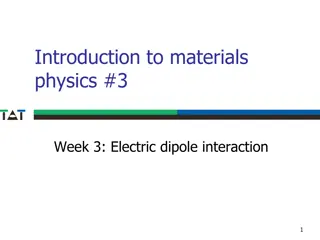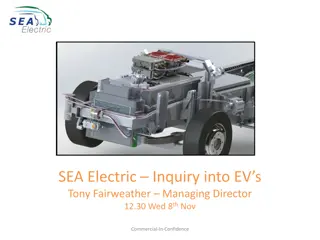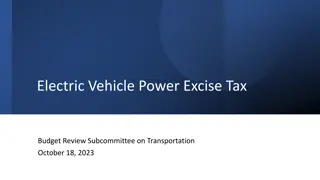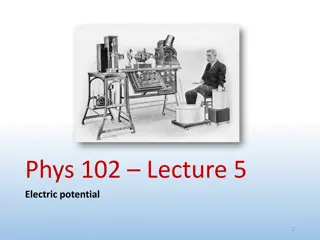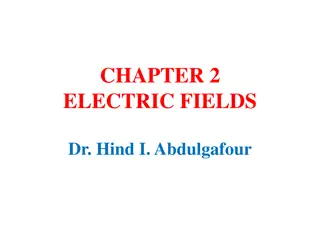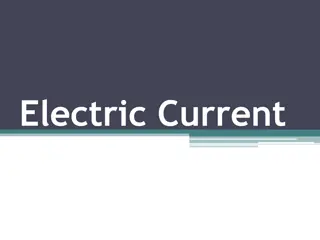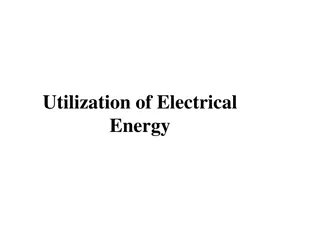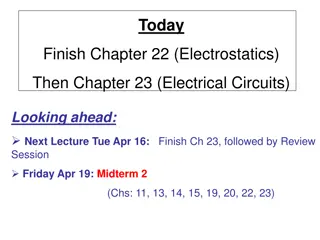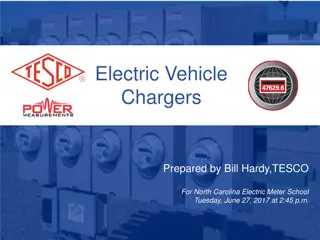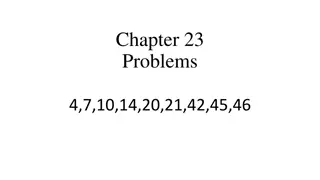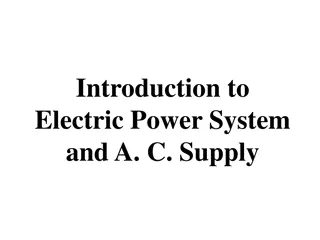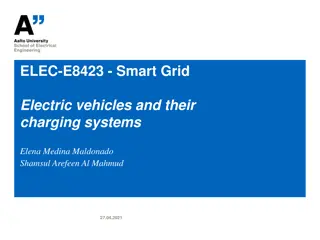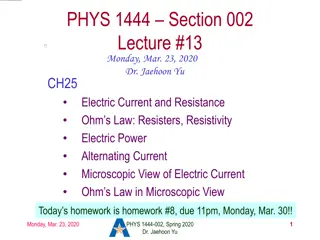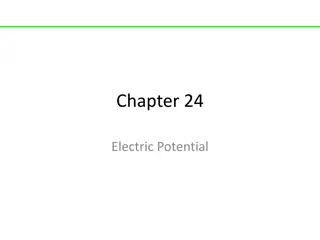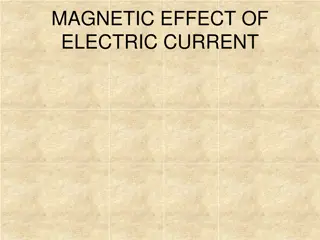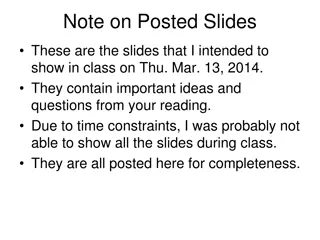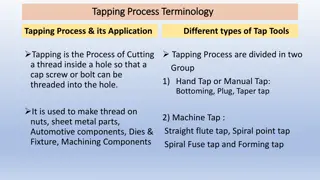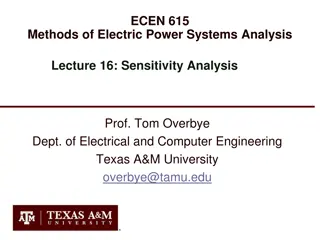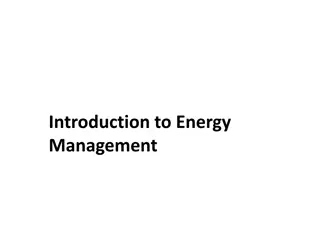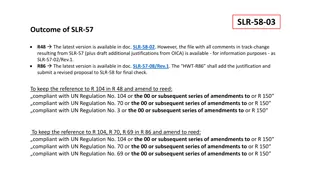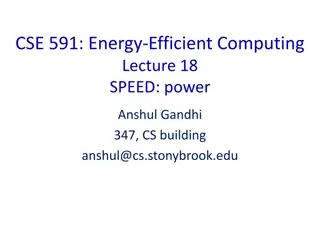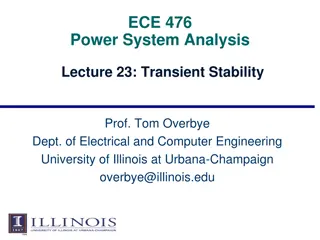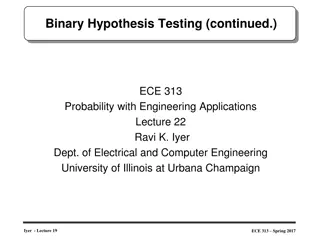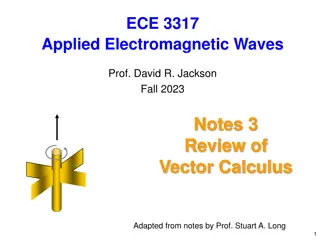Understanding Electric Power Systems - ECE 333 Final Review
Explore the comprehensive final review for ECE 333 course, covering fundamentals of electric power, renewable energy systems, energy economics, and more. Prepare for the exam with notes on energy integration, system context, and economic considerations in electric generation technologies.
Uploaded on Sep 28, 2024 | 0 Views
Download Presentation

Please find below an Image/Link to download the presentation.
The content on the website is provided AS IS for your information and personal use only. It may not be sold, licensed, or shared on other websites without obtaining consent from the author. Download presentation by click this link. If you encounter any issues during the download, it is possible that the publisher has removed the file from their server.
E N D
Presentation Transcript
ECE 333 Final Review, Spring 2015
Notes This review does not cover all of the course material and IS NOT a reflection of exactly what will be covered the exam Final Exam is Friday, May 8th, 7-10PM A-J in ECEB 3017 K-Z in ECEB 1013 Final is comprehensive, will cover everything with an emphasis on more recent material. You are allowed 3 handwritten notesheets Similar format to midterms, only slightly longer MC, T/F, 3 longer problems, some short answer
ECE 333 Syllabus ECE 333 Syllabus Introduction, fundamentals of electric power Electric Power Grid, Conventional Generation Wind Power Systems Wind/Grid Integration, Introduction to Power Flow The Solar Resource Photovoltaic Materials and Systems Smart Grid Integration Issues Distributed Generation Technologies (e.g., fuel cells) Economics of Distributed Resources Energy Storage including Electric/Hybrid Cars 3
Notation Notation - - Energy Energy Energy: Integration of power over time; energy is what people really want from a power system Energy Units Joule = 1 Watt-second (J) = Kilowatthour (3.6 x 106 J) = 1055 J; 1 MBtu=0.292 MWh; 1MWh=3.4MBtu kWh Btu One gallon of gas has about 0.125 MBtu (36.5 kWh); one gallon ethanol as about 0.084 Mbtu (2/3 that of gas) U.S. electric energy consumption is about 3600 billion kWh (about 13,333 kWh per person) 4
Electric Systems in Energy Context Electric Systems in Energy Context Class focuses on renewable electric systems, but we first need to put them in the context of the total energy delivery system Electricity is used primarily as a means for energy transportation Use other sources of energy to create it, and it is usually converted into another form of energy when used Concerns about need to reduce CO2 emissions and fossil fuel depletion are becoming main drivers for change in world energy infrastructure 5
Energy Economics Energy Economics Electric generating technologies involve a tradeoff between fixed costs (costs to build them) and operating costs Nuclear and solar high fixed costs, but low operating costs (though cost of solar has decreased substantially recently) Natural gas/oil have low fixed costs but can have higher operating costs (dependent upon fuel prices) Coal, wind, hydro are in between Also the units capacity factor is important to determining ultimate cost of electricity 6
Power System Structure Power System Structure All power systems have three major components: Load, Generation, and Transmission/Distribution. Load: Consumes electric power Generation: Creates electric power. Transmission/Distribution: Transmits electric power from generation to load. A key constraint is since electricity can t be effectively stored, at any moment in time the net generation must equal the net load plus losses 7
Large Large- -Scale Power Grid Overview Scale Power Grid Overview 8
GENERATION GENERATION Large plants predominate, with sizes up to about 1500 MW with wind a rapidly growing source. Coal is still the most common source but with a value falling from 56% a few years ago to 39% now. Natural gas has rapidly grown due to low costs, now making 27% of total. Nuclear (20%), hydro (6%), wind (4.3%), wood (1.0%), solar (0.4%, high growth) New construction is mostly natural gas and wind with economics highly dependent upon the gas price Generated at about 20 kV for large plants, around 600 V for many wind turbines; solar PV is dc. 9
Carnot Efficiency of Heat Engines Carnot Efficiency of Heat Engines Heat engines use differences in temperature to convert part of the heat from a high temperature source, QH, into work, W, with output heat QC Examples are fossil fuel generators, nuclear generators, concentrated solar generators and geothermal generator Net work output W Q = Thermal Efficiency = = Total heat input Q W Q = + H H C T T Carnot Maximum Efficiency = 1 - C H 10
Coal Plant Example Coal Plant Example Assume capital costs of $4 billion for a 1600 MW coal plant with a FCR of 10% and operation time of 8000 hours per year. Assume a heat rate of 10 Mbtu/MWh, fuel costs of 1.5 $/Mbtu, and variable O&M of $4.3/MWh. What is annualized cost per kWh? Fixed Cost($/kW) = $4 billion/1.6 million kW=2500 $/kW Annualized capital cost = $250/kW-yr Annualized operating cost = (1.5*10+4.3)*8000/1000 = $154.4/kW-yr Cost = $(250 + 154.4)/kW-yr/(8000h/yr) = $0.051/kWh 11
Complex Power Complex Power V= RMS V I Power triangle V S I=RMS Q I ( V- I) Asterisk denotes complex conjugate * VI RMS RMS V I V I = S Apparent power P ( ) = V I ( ) ( ) * + VI cos sin RMS RMS jV Q Reactive Power I RMS RMS V I V I P Real Power S = P+jQ 12
Power Factor Correction Example Power Factor Correction Example Assume we have a 100 kVA load with pf = 0.8 lagging, and would like to correct the pf to 0.95 lagging We have: 1 = = cos (0.8) 36.9 S 80 = We want: + 60 kVA j 1 desired = = cos (0.95) 18.2 Q S 18.2 . = des P 26.3kVAr tan(18.2 ) Qdes.=? = = tan(18.2 )*40 Q P=80 . des This requires a capacitance of: Q=60 P Q=-33.7 = 60 26.3 = 33.7 kVAr Q cap Qdes=26.3 13 P
Balanced 3 Phase ( Balanced 3 Phase ( ) Systems ) Systems A balanced 3 phase ( ) system has three voltage sources with equal magnitude, but with an angle shift of 120 equal loads on each phase equal impedance on the lines connecting the generators to the loads Bulk power systems are almost exclusively 3 Single phase is used primarily only in low voltage, low power settings, such as residential and some commercial 14
Advantages of 3 Advantages of 3 Power Power Can transmit more power for same amount of wire (twice as much as single phase) Torque produced by 3 machines is constrant Three phase machines use less material for same power rating Three phase machines start more easily than single phase machines 15
Per Phase Analysis Procedure Per Phase Analysis Procedure To do per phase analysis 1. Convert all load/sources to equivalent Y s 2. Solve phase a independent of the other phases 3. Total system power S = 3 Va Ia* 4. If desired, phase b and c values can be determined by inspection (i.e., 120 degree phase shifts) 5. If necessary, go back to original circuit to determine line-line values or internal values. 16
Transformers Overview Transformers Overview Power systems are characterized by many different voltage levels, ranging from 765 kV down to 240/120 volts. Transformers are used to transfer power between different voltage levels. The ability to inexpensively change voltage levels is a key advantage of ac systems over dc systems. In 333 we just introduce the ideal transformer, with more details covered in 330 and 476. 17
Ideal Transformer Ideal Transformer We ll develop the voltage/current relationships for an ideal transformer no real power losses magnetic core has infinite permeability no leakage flux We ll define the primary side of the transformer as the side that usually takes power, and the secondary as the side that usually delivers power. primary is usually the side with the higher voltage, but may be the low voltage side on a generator step-up transformer. 18
Key Problems with Harmonics Key Problems with Harmonics A key problem with the third harmonic is neutral current since the fundamental 120 degree phase shift becomes 360 degrees for the third harmonic so the third harmonic values do not cancel (also true for other triplen harmonics) Delta-grounded wye transformers prevent triplen harmonic currents from flowing into the power grid Harmonics cause transformer overheating since core losses are proportional to frequency Harmonic resonance, particularly with shunt capacitors (can be around 5th or 7th harmonic values) 19
Power Flow Power Flow A common power system analysis tool is the power flow It shows how real and reactive power flows through a network, from generators to loads Solves sets of non-linear equations enforcing "conservation of power" at each bus in the system (a consequence of KCL) Loads are usually assumed to be constant power Used to determine if any transmission lines or transformers are overloaded and system voltages Educational version PowerWorld tool available at http://www.powerworld.com/gloversarmaoverbye 20
Generator Costs Generator Costs There are many fixed and variable costs associated with power system operation. The major variable cost is associated with generation. Cost to generate a MWh can vary widely. For some types of units (such as hydro and nuclear) it is difficult to quantify. Many markets have moved from cost-based to price- based generator costs 21
Types of Wind Turbines Types of Wind Turbines Windmill - used to grind grain into flour or pump water Many different names - wind-driven generator , wind generator , wind turbine , wind-turbine generator (WTG) , wind energy conversion system (WECS) Can have be horizontal axis wind turbines (HAWT) or vertical axis wind turbines (VAWT) Groups of wind turbines are located in what is called either a wind farm or a wind park 22
Power in the Wind Power in the Wind Combining previous equations, 1 2 ( ) = 2 Power through area A A v v 1 2 = A (6.4) v 3 Power in the wind P W PW (Watts) = power in the wind (kg/m3)= air density (1.225kg/m3at 15 C and 1 atm) A (m2)= the cross-sectional area that wind passes through v (m/s)= windspeed normal to A (1 m/s = 2.237 mph) 23
Power in the Wind (for reference solar is Power in the Wind (for reference solar is about 600 w/m^2 in summer) about 600 w/m^2 in summer) Power increases with the cube of wind speed Doubling the wind speed increases the power by eight Energy in 1 hour of 20 mph winds is the same as energy in 8 hours of 10 mph winds Nonlinear, so we cannot use average wind speed 24
Power in the Wind Power in the Wind 1 2 = A v 3 P W Power in the wind is also proportional to A For a conventional HAWT, A = ( /4)D2, so wind power is proportional to the blade diameter squared Cost is somewhat proportional to blade diameter This explains why larger wind turbines are more cost effective (plus, as we shall see, because they are higher, the winds are stronger) 25
Tip Tip- -Speed Ratio (TSR) Speed Ratio (TSR) Efficiency is a function of how fast the rotor turns Tip-Speed Ratio (TSR) is the speed of the outer tip of the blade divided by wind speed Rotor tip speed Wind speed rpm D = Tip-Speed-Ratio (TSR) = (7.30) 60v D = rotor diameter (m) v = upwind undisturbed wind speed (m/s) rpm = rotor speed, (revolutions/min) One meter per second = 2.24 miles per hour 26
Electric Machines Electric Machines Electric machines can usually function as either a motor or as a generator Three main types of electric machines DC machines: Advantage is they can directly operate at variable speed. For grid application the disadvantage is they produce a dc output. Used for small wind turbines. AC synchronous machines Operate at fixed speed. Used extensively for traditional power generation. The fixed speed had been a disadvantage for wind. AC induction machines Very rugged and allow some speed variation but usually not a lot for efficient operation. 27
Slip Slip The difference in speed between the stator and the rotor 1 N s = rotor slip positive for a motor, negative for a generator NS = no-load synchronous speed (rpm) f = frequency (Hz) p = number of poles NR = rotor speed (rpm) N N N N = = S R R S S 120 f = N S p 28
Rayleigh Statistics Rayleigh Statistics Average Power in the Average Power in the Wind Wind To figure out average power in the wind, we need to know the average value of the cube of velocity: 1 1 2 2 avg ( ) A v = = 3 3 P Av avg avg With Rayleigh assumptions, we can write the (v3)avg in terms of vavg and the expression for average power in the wind is just ( 2 6 1 ) 3 = P A v avg avg This is an important and useful result 29
Real Data vs. Rayleigh Statistics Real Data vs. Rayleigh Statistics This is why it is important to gather as much real wind data as possible 30
Wind Farms Wind Farms Normally, it makes sense to install a large number of wind turbines in a wind farm or a wind park Benefits Able to get the most use out of a good wind site Reduced development costs Simplified connections to the transmission system Centralized access for operations and maintenance How many turbines should be installed at a site? 31
Bus Admittance Matrix or Ybus First step in solving the power flow is to create what is known as the bus admittance matrix, often call the Ybus. The Ybus gives the relationships between all the bus current injections, I, and all the bus voltages, V, I = YbusV The Ybus is developed by applying KCL at each bus in the system to relate the bus current injections, the bus voltages, and the branch impedances and admittances 32
Power Flow Slack Bus We can not arbitrarily specify S at all buses because total generation must equal total load + total losses We also need an angle reference bus. To solve these problems we define one bus as the "slack" bus. This bus has a fixed voltage magnitude and angle, and a varying real/reactive power injection. A slack bus does not exist in the real power system. 33
Real Power Balance Equations n n j * * = + = = S ( ) P jQ V ik k Y V V V e G jB ik i i i i i k ik ik = = 1 1 k k n = + (cos sin )( ) V V j G jB i k ik ik ik ik = 1 k Resolving into the real and imaginary parts n = + = P ( cos sin ) V V G B P P i i k ik ik ik ik Gi Di = 1 k n = = Q ( sin cos ) V V G B Q Q i i k ik ik ik i k Gi Di = 1 k 34
Power Flow Variables Assume the slack bus is the first bus (with a fixed voltage angle/magnitude). We then need to determine the voltage angle/magnitude at the other buses. = + ( ) x P P P 2 2 2 2 G D + + x ( ) ( ) x P Gn P Q P Q n n Dn = x ( ) f x V Q 2 2 2 2 G D + ( ) x V Q Q Q n n Gn Dn
N-R Power Flow Solution The power flow is solved using the same procedure discussed last time: ( ) v = x x Set 0; make an initial guess of , v ( ) v f x While ( ) Do + ( 1) ( ) v ( ) v 1 ( ) v v = = x x J x f x ( ) ( ) + 1 v v End While
Newton Newton- -Raphson Comments Raphson Comments When close to the solution the error decreases quite quickly -- method has quadratic convergence f(x(v)) is known as the mismatch, which we would like to drive to zero Stopping criteria is when f(x(v)) < Results are dependent upon the initial guess. What if we had guessed x(0) = 0, or x (0) = -1? A solution s region of attraction (ROA) is the set of initial guesses that converge to the particular solution. The ROA is often hard to determine 37
The Solar Resource The Solar Resource Before we can talk about solar power, we need to talk about the sun Need to know how much sunlight is available Can predict where the sun is at any time Insolation : incident solar radiation Want to determine the average daily insolation at a site Want to be able to chose effective locations and panel tilts of solar panels 38
Solar Position at Any Time of Day Solar Position at Any Time of Day Described in terms of altitude angle and azimuth angle of the sun S and S depend on latitude, day number, and time of day Azimuth angle ( S ) convention positive in the morning when sun is in the east negative in the evening when sun is in the west reference in the Northern Hemisphere (for us) is true south Hours are referenced to solar noon 39
PV System Overview PV System Overview Solar cell is a diode Photopower coverted to DC Shadows & defects convert generating areas to loads DC is converted to AC by an inverter Loads are unpredictable Storage helps match generation to load Shadows 40
General PV Cell Equivalent Circuit General PV Cell Equivalent Circuit The general equivalent circuit model considers both parallel and series resistance Equivalent Circuit V R = ( ) d I I I Rs SC d I P (minimize) = I R Id V V Photocurrent + + d S (maximize) Load ISC RP Vd - V - source + V R I R ( ) + / q kT V R I = ( ( -1)) S I I I e S 0 SC P 41
Shading Mitigation Shading Mitigation Solution - bypass diodes to bypass the shaded cell Instead of an I(RP+RS) voltage drop across the resistors, only a fixed voltage drop due to the diode, about 0.6 V (or even smaller with special diodes) No effect during normal operation 42
Annualized Investment Annualized Investment Then, the equal annual payments are given by (1 ) (1 ) 1 d + + CRF( , ) (5.20) A P i n = = + + n d d Capital Recovery Factor (CRF) = = A P n The capital recovery factor, CRF(i,n), is the inverse of the present value function PVF CRF measures the speed with which the initial investment is repaid Capital recovery function in Microsoft Excel: PMT(rate,nper,pv) 43
Internal Rate of Return Internal Rate of Return Until now, we have always specified the interest rate or discount rate Now we ll solve for the rate at which it makes sense to do the project This is called the internal rate of return, also called the break-even interest rate Higher is better because a higher IRR means that even if the interest rate gets higher, the project still makes sense to do Note there is no closed form solution - use a table (or Excel, etc.) to look it up 44
Amortizing PV Costs Amortizing PV Costs Simple payback is the easiest analysis, which assumes there is no cost for money and no inflation. Annual cost is just total cost divided by lifetime This can give a quick ballpark figure Example: Assume 5 kW system with a capacity factor of 18%, an installed cost of $ 5/W (after tax credits), and a lifetime of 20 years with no maintenance costs. What is $/kWh? ( $1250/yr = 5 kW 0.18 8760 7884 kWh/yr ) $5/W 5000 W20 yrs =$0.158/ kWh 45
Amortizing PV Costs Amortizing PV Costs More detailed analysis uses the capital recovery factor using an assumed discount rate Redo the previous example using a discount rate of 5% per year (1 ) 0.05 1.05 25,000 (1 ) 1 0.1327 25,000 2006.6 1.6533 + + n 20 d d = = = = A P + + n 20 d 1.05 1 = = = = A These values vary linearly with the assumed PV installed cost $2006.6/yr 7884 kWh/yr =$0.2545/ kWh 46
Batteries and PV Systems Batteries and PV Systems Batteries in PV systems provide storage, help meet surge current requirements, and provide a constant output voltage. Lots of interest in battery research, primarily driven by the potential of pluggable hybrid electric vehicles $2.4 billion awarded in August 2009 There are many different types of batteries, and which one is best is very much dependent on the situation Cost, weight, number and depth of discharges, efficiency, temperature performance, discharge rate, recharging rates 47
DC Motors DC Motors Main types are based on how the stator is powered: Separately excited (separate windings) Permanent magnet Shunt connection (field winding is in parallel with the armature); these motors have near constant speed regardless of load Series connection (field winding is in series with armature); these motors have high torque at low speed, but can have high speed with low torque 48
Example: Energy to Pump Water from Example: Energy to Pump Water from Shallow Well Shallow Well How many kWh/day are required to pump 250 gallons/day with a 66 ft head + 230 ft pressure head assuming 35% efficiency? With efficiency given, the below equation works for any rate, so calculate power required if the 250 gallons is pumped in one hour . ( ) ( ( ) elec P W Efficiency 250gal day Q gal 60 d . . ( ) . . kWh Answer 0 664 = $0.02 per 100 gallons / min) 0 1885 H ft Q gal = / = = ( / min) . / min 4 167gal min/ ay 0 1885 296 4 167 0 35 = = W (for one hour) elec P W 664 Cost is about $0.05 or 49
Types of Hydro Types of Hydro Impoundment (or Storage) is the most common, usually with a dam used to store river water in reservoir Multiple dams can be chained together Management of water usage can get quite complex, with lots of side issues such as flood control and maintaining flow rates for fish Water released from one reservoir becomes available to the one downstream reservoirs (and plants) Constraint on total water available over a year (or longer) Image: http://energy.gov/eere/water/types-hydropower-plants 50


